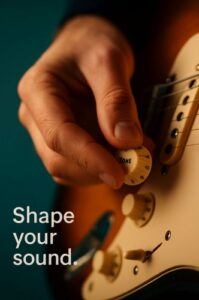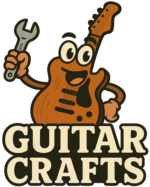When it comes to assembling or customizing your DIY guitar build, playing with tone controls is one of the most effective ways to shape your sound and personalize your playing experience. In this post, Playing With Tone Controls: Tips For Electric Guitar Kits, we’ll explore how small adjustments to tone pots, EQ settings, and playability factors can make a massive difference in the final feel and tone of your instrument. Whether you’re chasing classic blues warmth or modern rock bite, understanding how to master these controls is key to unlocking your kit’s full potential. From pickup positioning to EQ settings, there’s a whole world of subtle but powerful adjustments that can make your DIY guitar project feel and sound professional.

In this guide, we’ll walk you through the foundational elements of electric guitar tone, show you how to make your guitar easier to play, and explore advanced tips for shaping your tone — especially if you’re chasing that rich, throaty sound. Whether you’re assembling your first kit or upgrading a budget model, understanding how to tweak your tone controls can elevate your build from good to great.
** Here’s a little transparency: Our website contains affiliate links. This means if you click and make a purchase, we may receive a small commission. Don’t worry, there’s no extra cost to you. It’s a simple way you can support our mission to bring you quality content. **
As an Amazon Associate, I earn from qualifying purchases.
Understanding Tone Controls: The Foundation of Electric Guitar Kits
Tone controls are more than just knobs on your guitar — they’re tools for sculpting sound. In any electric guitar kit, the tone control circuit usually includes capacitors and potentiometers (pots) that filter out high frequencies, letting you shape brightness and warmth.

But tone starts well before the electronics. Your guitar’s tone is the result of several key components working together:
- Wood type: Different body woods (like mahogany or alder) resonate differently, subtly coloring your tone.
- Pickups: Single coils tend to sound bright and crisp, while humbuckers offer a warmer, thicker tone.
- Strings: Gauge and material both influence how your guitar responds and feels.
![]()
The tone controls are your way of adjusting the balance among these elements. Dialing them in can enhance clarity, reduce muddiness, or create a specific vibe — whether you’re going for surfy twang or smoky blues.
Making Your Electric Guitar Easier to Play: Tips and Tricks
Before you even start fiddling with EQ or pedals, make sure your guitar feels good in your hands. Here are a few key setup tips that directly influence playability — and how you interact with tone controls:
1. Fine-Tune the Action and Intonation

Low action makes your guitar easier to play, but too low can cause fret buzz. Use feeler gauges and ruler measurements to set your string height to suit your playing style.
Accurate intonation ensures every note rings true. You can adjust this by moving your bridge saddles or checking with a strobe tuner.
2. Neck Adjustments and Truss Rod Tweaks

A properly adjusted truss rod ensures your neck has the right amount of relief (slight forward curve). Too much relief makes it hard to press strings, while too little can cause buzzing. Small quarter-turn adjustments make a big difference.
3. Choose Strings That Fit Your Style

Lighter strings bend more easily and feel slinkier—great for blues and lead work. Heavier gauges add sustain and fuller tone, ideal for rhythm or drop tuning. Match your string choice with how you want to use your tone controls. A darker-sounding string might require more treble through your tone pot or amp EQ.
Key Elements Influencing Electric Guitar Tone
The sound your guitar makes is the result of several combined choices — not just what knobs you turn.
Pickup Type and Position

A pickup near the bridge sounds brighter and punchier. One near the neck gives you a warmer, bass-heavy tone. Humbuckers generally sound smoother and thicker; single coils bring out more sparkle and clarity. Blending pickup positions with tone controls lets you dial in the exact flavor you’re after.
Body Material and Build

Different woods and body constructions — solid, semi-hollow, or chambered — resonate differently. For example, a maple top can bring out brightness, while mahogany offers warmth and sustain.
Amplifiers and Accessories
Even with the perfect guitar setup, your amp and signal chain play a massive role in shaping final tone. EQ controls on amps interact with your guitar’s tone controls, so understanding both is crucial.
Check out our post How Pickup Position Affects Electric Guitar Tone In Kits for deeper insights into how these factors shape your core tone.
Achieving the Perfect EQ Settings for Your Electric Guitar
Once your guitar is playable and your tone controls are set, it’s time to dial in the amp. Here’s how EQ settings affect your tone — and how to find the sweet spot.
Understanding EQ Basics

EQ (Equalization) typically includes bass, midrange, and treble controls. Each band shapes different parts of your tone:
- Bass: Controls low-end thump and fullness.
- Midrange: Crucial for note definition and presence in the mix.
- Treble: Adds sparkle and clarity.
How to Set EQ for Different Styles

- Blues: Boost mids, slightly cut highs for warmth.
- Metal: Scoop the mids, boost lows and highs.
- Jazz: Roll off treble and bass, emphasize mids for smooth tones.
- Funk: Boost highs and mids, reduce bass for clean articulation.
Avoiding Common EQ Mistakes

Don’t crank all knobs to 10. Over-boosting any frequency band can muddy your tone or make it too sharp. Instead, make small adjustments and listen critically. Let your tone controls on the guitar do part of the work — they’re there for fine-tuning before the amp takes over.
Crafting a Throaty Guitar Tone: Advanced Techniques

What exactly is a “throaty” tone? It’s a rich, vocal-like midrange that cuts through a mix without being harsh. Think of classic blues solos or expressive lead work — tones that seem to “speak.”
Building That Sound
- Gain: A touch of overdrive helps fatten your tone without muddying it.
- Mids: This is where the throaty magic lives. Use both your amp and guitar tone controls to boost this range.
- Bass: Keep it tight. Too much low end will mask the throaty characteristics.
Add Effects to Taste
Overdrive, boost pedals, and even wah can help shape this vocal quality. You can also experiment with parametric EQ pedals for precise midrange control.
For more ideas on how pickups affect this, see our post Best Pickups For Your Electric Guitar Kit: Choosing The Right Tone.
Final Thoughts: Mastering Tone is an Ongoing Journey
Playing with tone controls is about more than tweaking knobs — it’s about unlocking the full potential of your electric guitar kit. From choosing the right strings and pickups to setting EQ and exploring advanced tone techniques, every decision contributes to your sound.
Once you understand the interplay between tone controls, playability, and gear, you can customize your tone to fit any genre or personal style. Whether you’re chasing a smooth jazz tone or gritty blues growl, it all starts with knowledge and experimentation.
Looking to level up your DIY guitar building skills? Check out our other guides:
- Essential Tools Every Electric Guitar Kit Builder Should Have
- How To Choose The Perfect Nut Material For Your Electric Guitar
- Customizing Your Electric Guitar Kit With Unique Fretboard Inlays
There are 100’s of ways you can build a business around your passion for guitar building.
Check it out…



Tone is more than gear — it’s how wood, pickups, strings, and controls work together. Whether you’re building your first kit or upgrading a budget guitar, learning how to shape your sound is what takes it from basic to expressive.
This guide breaks it down simply: how to tweak your setup for warmth, clarity, or that throaty blues tone — no guesswork, just practical steps.
Absolutely spot on — tone is the sum of so many parts, not just gear. It’s awesome to see you highlight how critical the interplay between wood, pickups, strings, and controls really is. That’s exactly what we aim to show: shaping your sound doesn’t have to be a mystery. Glad the guide hit the mark and gave you some clear steps to dial in the tone you’re after. Keep experimenting — that’s where the magic lives!
Thanks for this detailed insight on tone controls and guitar setup! It’s great to see how small tweaks can really transform both playability and sound. I especially appreciate the tips on matching string gauge to your playing style and how wood type influences tone.
I’m curious—when you’re dialing in tone controls on a new DIY kit, do you usually start by focusing on the pickups or the amp settings first? And do you find one has more impact on shaping your ultimate sound?
I’m glad the post resonated! Those little tweaks really do add up when it comes to tone and feel. Great questions! When I’m dialing in tone controls on a new DIY kit, I usually start with the pickups and guitar settings first. Things like height, tone pot values, and cap choices, since that’s the foundation of the signal. Once that’s sounding balanced, I’ll move on to the amp to fine-tune for the space and style I’m going for. That said, the amp definitely has a huge influence too, especially with EQ and gain shaping.
So, it’s all about getting them to work together.
Thank you so much!
This was such a well-rounded guide that went beyond just “turn the knob and listen”. I really liked how you connected tone controls to pickup choice, string gauge, wood type, and EQ settings. The section on achieving a throaty tone was especially insightful, and I appreciate the clear examples for different music styles. It’s great to see practical setup tips included too, since playability and tone are so closely linked. In your experience, which adjustment pickup position, string gauge, or EQ tends to have the most immediate and noticeable impact for beginners experimenting with tone?
Thanks so much for your kind words! I’m glad the guide gave you a well-rounded view of tone controls and how they interact with other factors. To answer your question… pickup position often provides the most immediate and noticeable change for beginners. It can really transform the character of your tone right away. String gauge also makes a big difference, especially in feel and brightness, but it’s a bit more subtle and takes some getting used to. EQ adjustments are powerful but can be less intuitive at first, so I usually recommend starting with pickup position tweaks and then exploring string gauge and EQ as you get more comfortable.
Experimenting step-by-step helps beginners dial in their sound without feeling overwhelmed!
Thanks again…
Your article looks great, Wayne. I’ve never used an electric guitar or built a DIY one, but your breakdown of tone controls and playability tips — while it seemed complex at first — was very clear and helpful. I also liked how you explained not just the role of the pots and EQ, but also how pickups, wood type, and string choice can affect the final sound. The section about achieving a throaty tone was especially interesting to me. Out of curiosity, for someone starting out with their first kit, would you suggest focusing on mastering the guitar’s tone controls first, or learning how to shape tone from the amp?
Thanks so much! I’m glad the guide made tone controls feel approachable. Even for someone new to electric guitars.
Great question, by the way…
For beginners, I usually suggest starting with the amp first. Understanding how EQ and gain settings shape your overall sound gives you a foundation to make more meaningful tweaks on the guitar itself. Once you get comfortable with that, exploring the guitar’s tone controls becomes a lot more intuitive—you’ll really hear how small adjustments on the pots interact with your amp and pickups. Basically, learn the big picture first, then fine-tune the details on the guitar.
Thanks again,
~Wayne
My uncle sets his electric guitar quite low and it does make sort of buzzy sounds. So does this mean the guitar is set too low? He has a Mahogany guitar.
I am going to forward him this website, as I am sure it will give him some tips and ideas for his hobby. I don’t think he has ever built his own guitar, but he has bought a few over the years, and some of them have been hand crafted.
That’s awesome that your uncle is into guitars! Sounds like he’s got a great collection going! A low action (when the strings sit closer to the fretboard) can definitely cause buzzing, especially if the neck or frets aren’t perfectly leveled. Sometimes it’s just a matter of adjusting the truss rod or bridge height to find that sweet spot between comfort and clean tone. Mahogany guitars are known for their warm, rich sound, so with a little setup tweaking he could really get the best out of it. I think he’ll enjoy exploring the tips here even if he’s never built one.
Sometimes small adjustments can make a big difference!
Thank you so much!
~Wayne